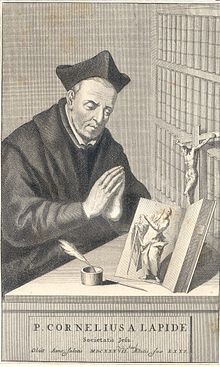- Cornelius a Lapide
-
Cornelius Cornelii a Lapide (né Cornelis Cornelissen van den Steen; 18 December 1567 – 12 March 1637) was a Flemish Jesuit and exegete.[1]
Contents
Life
He was born at Bocholt, in Belgian Limburg. He studied humanities and philosophy at the Jesuit colleges of Maastricht and Cologne, theology first, for half a year, at the University of Douai, and afterwards for four years at Catholic University of Leuven; he entered the Society of Jesus, 11 June 1592, and, after two years' novitiate and another year of theology, was ordained priest 24 December 1595. After teaching philosophy for half a year, he was made professor of Holy Scripture at Leuven in 1596 and next year of Hebrew also. Twenty years later, in 1616, he was called to Rome in the same capacity, where, on 3 November, he assumed the office which he filled for many years after. The latter years of his life, however, he seems to have devoted exclusively to finishing and correcting his commentaries. He died at Rome.
During his professorship at Leuven he liked to spend his holidays preaching and administering the sacraments, especially at the pilgrimage of Scherpenheuvel (Montaigu). He portrayed himself in a prayer to the Prophets at the end of his commentary on the Book of Daniel:
- "For nearly thirty years I suffer with and for you with gladness the continual martyrdom of religious life, the martyrdom of illness, the martyrdom of study and writing; obtain for me also, I beseech you, to crown all, the fourth martyrdom, of blood. For you I have spent my vital and animal spirits; I will spend my blood too."
Works
Cornelius a Lapide wrote commentaries on all the books of the Canon of Scripture (including the Deuterocanon), with the exception only of the Book of Job and the Psalms. Even before leaving Flanders, he edited the Commentaries in omnes divi Pauli epistolas (1614) and, In Pentateuchum (On the Pentateuch, 1616), both in Antwerp. The commentaries on the Greater and Lesser Prophets, on the Acts of the Apostles, the Canonical Epistles and the Apocalypse of St John, Wisdom of Sirach, and the Book of Proverbs, followed later on. The rest were edited only after his death; but all of them have been several times re-edited, both separately and collectively. Of the Commentary on the Epistles of St. Paul he himself lived to see at least eleven editions. The complete series, with Job and the Psalms added by other hands, appeared at Antwerp, 1681, 1714; at Venice, 1717, 1740, 1798; at Cologne, 1732; at Turin, 1838; at Lyons, 1839–42, 1865 and 1866; at Malta, 1843–46; at Naples, 1854; at Lyons and Paris, 1855 and 1856; at Milan, 1857; at Paris, 1859-63.
The most widely-mentioned edition has been complemented by Crampon and Péronne with annotations from more recent interpreters. All these commentaries are on a very large scale. They explain not only the literal, but also the allegorical, tropological, and anagogical sense of the sacred text, and furnish a large number of quotations from the Church Fathers and the later interpreters of Holy Writ during the Middle Ages. Like most of his predecessors and contemporaries, a Lapide intended to serve not only the historical and scientific study of the Bible, but, even more, the purposes pious meditation, and especially of pulpit exposition. An extract from the commentary on the Acts appeared in 1737 in Tyrnau, under the title: Effigies Sancti Pauli, sive idea vitæ apostolicæ. A large work in 4 vols., Les trésors de Cornelius a Lapide: extraits de ses commentaires de l'écriture sainte à l'usage des prédicateurs, des communautés et des familles chrétiennes, by the Abbé Barbier, was published at Le Mans and Paris, 1856, re-edited at Paris, 1859, 1872, 1876, 1885, 1896; and an Italian translation of the same by F. M. Faber, appeared at Parma, 1869–70, in 10 vols., 16 mo.
G. H. Goetzius (Leipzig, 1699) wrote an academical dissertation, Exercitatio theologica de Cornelii a Lapide Commentariis in Sacram Scripturam, in which he praises the Jesuit author as the most important of Catholic Scriptural writers. An English translation of the complete commentaries was undertaken by the Rev. Thomas W. Moseman, an Anglican clergyman, under the title, The great Commentary of Cornelius a Lapide (London, 1876-). A manuscript in the Vatican Library contains an Arabic translation of the Commentary on the Apocalypse, by Yusuf ibn Girgis (beginning of the eighteenth century). The same Maronite writer is said to have translated the Commentary on the Epistles of St. Paul.
References
- ^ "Cornelius Cornelii a Lapide". Catholic Encyclopedia. New York: Robert Appleton Company. 1913. http://www.newadvent.org/cathen/04377a.htm.
 This article incorporates text from a publication now in the public domain: Herbermann, Charles, ed (1913). "Cornelius Cornelii a Lapide". Catholic Encyclopedia. Robert Appleton Company.
This article incorporates text from a publication now in the public domain: Herbermann, Charles, ed (1913). "Cornelius Cornelii a Lapide". Catholic Encyclopedia. Robert Appleton Company.External links
Categories:- 1567 births
- 1637 deaths
- Belgian Jesuits
- Flemish people
- Biblical scholars
Wikimedia Foundation. 2010.

